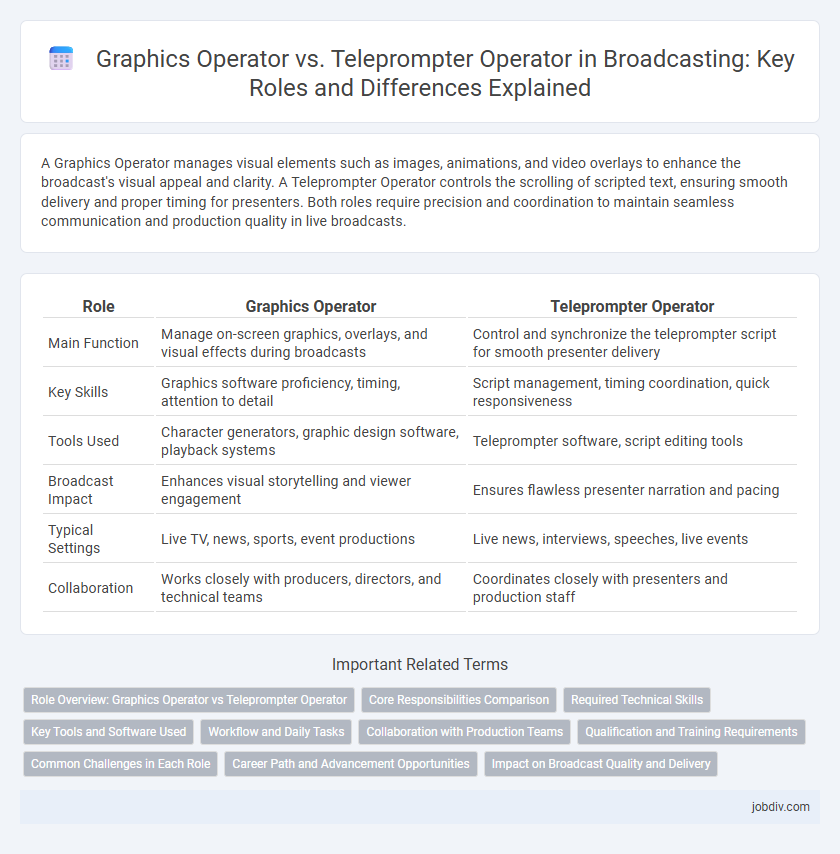A Graphics Operator manages visual elements such as images, animations, and video overlays to enhance the broadcast's visual appeal and clarity. A Teleprompter Operator controls the scrolling of scripted text, ensuring smooth delivery and proper timing for presenters. Both roles require precision and coordination to maintain seamless communication and production quality in live broadcasts.
Table of Comparison
| Role | Graphics Operator | Teleprompter Operator |
|---|---|---|
| Main Function | Manage on-screen graphics, overlays, and visual effects during broadcasts | Control and synchronize the teleprompter script for smooth presenter delivery |
| Key Skills | Graphics software proficiency, timing, attention to detail | Script management, timing coordination, quick responsiveness |
| Tools Used | Character generators, graphic design software, playback systems | Teleprompter software, script editing tools |
| Broadcast Impact | Enhances visual storytelling and viewer engagement | Ensures flawless presenter narration and pacing |
| Typical Settings | Live TV, news, sports, event productions | Live news, interviews, speeches, live events |
| Collaboration | Works closely with producers, directors, and technical teams | Coordinates closely with presenters and production staff |
Role Overview: Graphics Operator vs Teleprompter Operator
A Graphics Operator manages the visual elements on screen, including adding graphics, animations, and overlays to enhance the broadcast's visual storytelling. The Teleprompter Operator controls the scrolling text that anchors and presenters read during live or recorded segments, ensuring smooth and timely delivery of scripts. Both roles are essential for seamless production, with the Graphics Operator focusing on visual content and the Teleprompter Operator ensuring accurate dialogue pacing.
Core Responsibilities Comparison
Graphics Operators manage real-time visual content and on-screen graphics, ensuring seamless integration with live broadcasts to enhance viewer engagement. Teleprompter Operators focus on accurately displaying scripted content to on-air talent, maintaining scroll speed and synchronization with the broadcast flow. Both roles demand precise timing and coordination but differ in their direct impact on visual presentation versus speaker guidance.
Required Technical Skills
A Graphics Operator requires proficiency in real-time graphics software such as Vizrt or Chyron, alongside a strong understanding of video switching and layering techniques to enhance broadcast visuals. Teleprompter Operators must excel in script management software, precise timing, and seamless scrolling control to ensure on-air talent delivers scripts smoothly. Both roles demand quick problem-solving skills, attention to detail, and familiarity with live broadcast environments to maintain seamless production flow.
Key Tools and Software Used
Graphics Operators rely heavily on software like Adobe After Effects, Vizrt, and ChyronHego to create and manage real-time visual content during broadcasts. Teleprompter Operators utilize specialized teleprompting software such as Autocue, TeleScript, or QStart, ensuring seamless script display synchronized with live production cues. Both roles demand proficiency in integrating hardware controls and networked systems to maintain broadcast flow and visual accuracy.
Workflow and Daily Tasks
A Graphics Operator manages on-screen visual elements such as lower thirds, transitions, and animations, ensuring seamless integration with live broadcasts and pre-recorded segments. A Teleprompter Operator controls the scrolling of scripted text, synchronizing prompts with the presenter's pace to maintain smooth delivery. Workflow for Graphics Operators involves real-time editing and collaboration with producers and directors, while Teleprompter Operators focus on precise timing and text adjustments based on live performance cues.
Collaboration with Production Teams
Graphics Operators and Teleprompter Operators play crucial roles in live broadcasting, coordinating closely with production teams to ensure seamless delivery. Graphics Operators integrate real-time visuals and data overlays, working hand-in-hand with directors and technical crews to enhance visual storytelling. Teleprompter Operators synchronize script cues with on-air talent and production timing, maintaining fluid communication to prevent on-screen errors and support smooth broadcasts.
Qualification and Training Requirements
Graphics Operators require proficiency in graphic design software such as Adobe After Effects and Vizrt, supported by formal training in digital media or broadcasting technology. Teleprompter Operators need strong reading skills and coordination, often gaining expertise through specialized teleprompter training programs or on-the-job experience in live broadcast environments. Both roles demand attention to detail and the ability to perform under pressure, but Graphics Operators typically require more technical and software-based qualifications.
Common Challenges in Each Role
Graphics Operators face challenges like syncing visuals precisely with live broadcasts, managing complex software under tight deadlines, and troubleshooting technical glitches on the fly. Teleprompter Operators must maintain flawless script scrolling, adapt swiftly to last-minute script changes, and ensure seamless coordination with on-air talent to prevent delivery errors. Both roles demand acute attention to detail, rapid problem-solving skills, and effective communication within the production team.
Career Path and Advancement Opportunities
Graphics Operators in broadcasting typically advance by specializing in advanced animation software and live event production, leading to roles such as Graphics Supervisor or Broadcast Designer. Teleprompter Operators often progress through gaining expertise in script coordination and live production timing, advancing to Studio Manager or Floor Director positions. Both career paths benefit from technical proficiency and on-the-job experience, with opportunities for upward mobility increasing in larger networks and production companies.
Impact on Broadcast Quality and Delivery
Graphics Operators enhance broadcast quality by seamlessly integrating visual elements such as lower thirds, animations, and real-time data graphics, which engage viewers and clarify information. Teleprompter Operators ensure smooth delivery by providing precise script cues, minimizing on-air errors and maintaining presenter confidence and continuity. Both roles are critical in professional broadcasting environments, directly influencing the clarity, professionalism, and overall viewer experience.
Graphics Operator vs Teleprompter Operator Infographic

 jobdiv.com
jobdiv.com